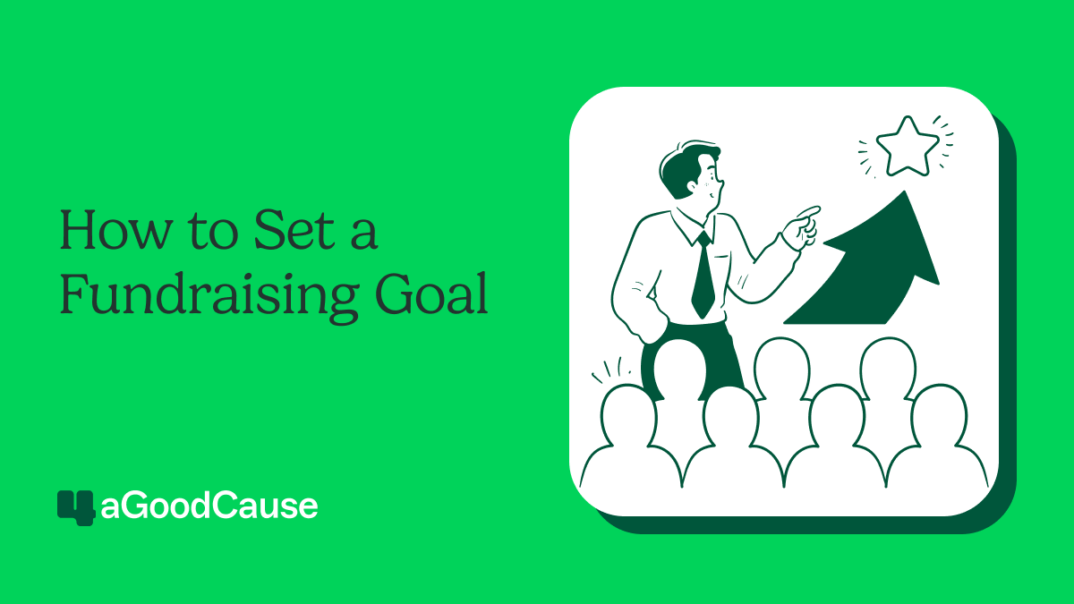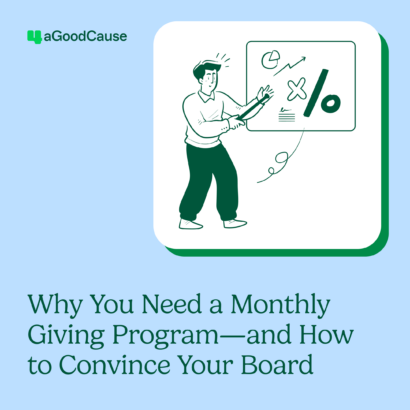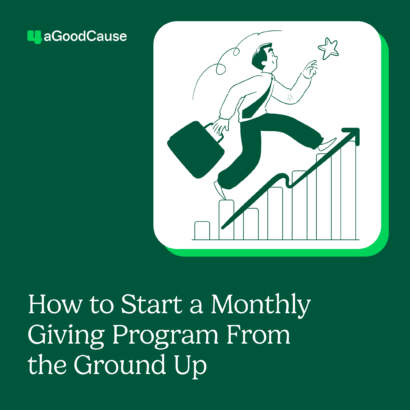I know how challenging it can be to set clear and achievable fundraising goals while juggling countless other responsibilities.
As someone who has worked closely with nonprofits for over 25 years, I’ve seen firsthand how overworked teams struggle to balance immediate needs with long-term planning.
That’s why I created this guide—to help simplify the goal-setting process and give you actionable steps to achieve fundraising success.
Here’s what I’ll cover below:
- How to specify your fundraising goals that are both aspirational AND achievable
- Important best practices that will help you meet the goals you set
- Best ways to leverage fundraising tools to meet your goals
- What to keep in mind when planning your next fundraising initiative
Whether you’re trying to engage new donors, retain current supporters, convert one-time givers to recurring donors, or plan your next campaign, I’m here to support you every step of the way.
🤯 Did you know? 4aGoodCause makes setting up custom fundraising pages and campaigns a breeze and makes recurring monthly giving easier than ever—for you and your donors both. Book a demo to learn more
Set attainable, data-informed SMART goals
Think of setting your fundraising goals as you would any goal in business or in life: Make them S.M.A.R.T.
This tried-and-true goal-setting framework ensures your nonprofit fundraising efforts are both effective and achievable.
Before we dig in, let’s break down what it takes to set achievable goals—your targets should be:
- Specific: Identify a specific amount of money to raise or a percentage increase compared to last year, decide on the fundraising types you’ll use, and a set deadline for your campaign.
- Measurable: Outline how you’ll track your team’s success by using measurable goals, such as the number of new donors you’re aiming for, or the amount of money raised.
- Attainable: Make your goals a challenge, yet achievable. Set realistic goals based on your nonprofit’s historical metrics and growth patterns.
- Realistic: Ensure your goals are something your existing community can rally behind and your fundraising team can effectively promote.
- Time-bound: Create a timeframe that aligns with your nonprofit’s specific fundraising goals, routine fundraising activities and campaigns, and overall development and growth strategy.
Using the SMART framework ensures your nonprofit organization has clear goals that drive fundraising success.
For example, instead of setting a vague goal like “raise more than last year’s cornerstone fundraising event,” consider a goal like “increase donations by 25% compared to last year’s annual fundraising total.”
This keeps your team focused on measurable and realistic goals.
Define your goals, then get to work
Next up, let’s talk through the best ways to meet those SMART goals that you set.
- Call out your specific fundraising goals
- Name your impact
- Create urgency
- Utilize donation matching strategies
- Use the right tools
- Develop a Roadmap for Successful Fundraising
- Build Strong Donor Relationships
1. Call Out Your Fundraising Goals
Fundraising goals can go beyond a dollar amount.
While raising a specific amount of money is common, there are other ways to define success for your fundraising campaigns.
Consider setting goals for:
- Acquiring new donors: Set a goal to gain 150 new supporters total in Q1 and Q2.
- Peer fundraising: Focus on securing 25 new peer fundraising teams for an event.
- Donor retention rate: Aim to improve donor retention by 15% compared to last year.
- Recurring monthly donors: Increase conversion of one-time donors into recurring supporters.
- Building new partnerships: Set goals to gain five new corporate sponsors.
- Increase campaign capacity: Drive better processes for your planned campaigns (or amount of campaigns) for the year ahead.
Donor retention is a key metric for any nonprofit. The average donor retention is 46% for one-time donors but increases to 90% for monthly donors, notes Erica Waasdorp in Monthly Giving Made Easy.
Recurring donors provide sustained support that makes a big difference in achieving long-term goals, so I highly encourage you to include yearly goals around increasing recurring supporters as part of your growth plan.
Whatever your goal, write it down and share it with your internal fundraising team and stakeholders.
Communicate it widely through email campaigns, social media, and your nonprofit’s donation page to keep your potential donors engaged and motivated.
Visual tools like a fundraising thermometer can show real-time progress, keeping everyone excited and focused.
🧑🏽🏫 Learn more: The power of a fundraising thermometer
2. Name Your Impact
The impact drives the goal.
While numerical goals are important, align them with a cause your target audience can connect with emotionally.
For example, if your nonprofit’s goal is to feed 500 children over the summer, calculate the dollar amount needed and share the big picture:
- Clarify specific amounts: “We need $10,000 to provide 500 backpacks filled with food for kids this summer.”
- Validate donor behavior: Show how each donation amount contributes to the bigger picture (e.g., “$20 fills one backpack”).
- Communicate clear goals with stories: Use storytelling and visuals in your outreach to emphasize the tangible difference donors can make.
By pairing your fundraising plan with an impactful message, you connect the dots between your fundraising goals and the lives you’ll change.
This inspires both individual donors and major donors to take action.
3. Create a Sense of Urgency
Urgency is key to successful fundraising.
When setting fundraising goals, create milestones that drive momentum:
- Highlight time-bound goals like “Raise $10,000 in 24 hours.”
- Share progress updates during the campaign to encourage donor engagement and celebrate successes along the way.
- Use a fundraising platform to display real-time updates on your progress, like donations rolling in.
Urgency motivates potential donors to act quickly and makes fundraising initiatives feel dynamic and exciting.
💡 Did you know? Not every fundraising tool is created equal. Learn how 4aGoodCause can help you start and grow a recurring giving program that can help your team move mountains. Schedule a chat with us today.
4. Use Matching Donations for Added Impact
Setting goals around gift-matching can be a powerful tool for nonprofit fundraising campaigns.
Matching donors—whether by individuals, board members, or corporate partners—can double or even triple the impact of individual gifts.
Make sure to:
- Explore sponsorships: A company may match donations dollar-for-dollar up to $10,000. 4aGoodCause integrates with Double the Donation to make corporate gift-matching easy.
- Communicate donor matching options: If you have a gift matching partnership for certain giving thresholds, make that clear. Sharing that “Your $50 gift becomes $100 thanks to a matching donor” encourages immediate action.
Matching gifts increase the likelihood of donations and amplify fundraising success.
Incorporate this tactic into your next campaign to boost results.
Online fundraising platforms are essential for modern nonprofit fundraising.
There are plenty of tool options out there to help you organize your work, but make sure to consider all your options and choose the one that fits your team’s needs the most.
You can use these tools to:
Social media also plays a critical role.
Use platforms like LinkedIn to engage major donors or Facebook to promote crowdfunding efforts.
Email campaigns remain a powerful way to reach both current donors and new supporters.
Recurring giving is another area of opportunity for nonprofits where online giving tools like 4aGoodCause can help.
According to Neon One’s 2024 Recurring Giving Benchmark Study, “The average retention rate for recurring donors was 78% over the five-year period—for non-recurring donors, it was 36%.”
This highlights the importance of developing programs to encourage ongoing support.
In fact, recurring giving is growing steadily. Dataro’s 2024 Recurring Giving Benchmark Report found that “63.6% of organizations achieved revenue growth in recurring giving revenue in 2023.
These numbers underline the value of long-term donor relationships in creating sustainable impact.
To learn more about how to start and grow a successful monthly giving program, check out our Monthly Giving Toolkit.
6. Develop a roadmap for successful fundraising
A strong fundraising strategy requires careful planning. Use these tips to create a roadmap for success:
- Define your specific fundraising goals: Set clear, measurable, and time-bound goals for your campaign, like we discussed above.
- Identify your target audience: Tailor your messaging to reach specific donor segments.
- Engage your stakeholders: Collaborate with your board members, fundraising team, and partners.
- Track key metrics: Monitor KPIs (key performance indicators) like your donor retention rate, number of donors, and average gift size.
- Celebrate the successes: Acknowledge milestones to keep your team and donors motivated! (Don’t forget this part!)
Having a detailed roadmap helps your nonprofit take its fundraising efforts to the next level.
7. Build strong donor relationships
Donor management is an essential logistical piece of effective fundraising.
By storing and analyzing donor data, you can:
- Identify trends in donor behavior.
- Personalize outreach to specific donor segments.
- Keep donors engaged through consistent communication.
Retaining donors requires hard work and ongoing efforts, but it’s a vital part of long-term success.
Tools like nonprofit CRMs help track donor data and improve donor engagement for future campaigns.
Next up, let’s talk through the planning it takes to put this all together.
Review outcomes and plan your next fundraising initiative
As you know firsthand, fundraising is a cycle—and every successful fundraising campaign builds momentum for the next campaign.
After a campaign is completed, take time to go over the following with your team:
- Reflect on what worked well
- Discuss what can be improved
- Clarify if adjustment is needed to meet nonprofit fundraising goals for the future
Every step of the way, make sure to record and review important KPIs that will indicate if your on track to meet your annual goals.
By incorporating these steps into your nonprofit’s annual fundraising plan, you’ll set yourself up for continued success.
Simplify your fundraising initiatives and reach your goals this year with 4aGoodCause
Meeting your fundraising goals shouldn’t feel like a constant uphill battle.
With 4aGoodCause, you gain a powerful, intuitive fundraising CRM designed to help you set clear, actionable goals and grow your base of recurring monthly donors.
You’ll get unlimited customizable donation pages that integrate seamlessly into your overall strategy, empowering you to create and track campaigns effortlessly. In short, your donors enjoy a smooth giving experience while you benefit from streamlined, stress-free fundraising.
(That’s a win-win!)
Discover how a smarter system can lighten your workload and drive sustainable results—schedule a demo today!
For additional resources, make sure to sign up for our email newsletter. You’ll get exclusive invites to helpful webinars, tips for streamlining your workload, and regular encouragement from people who get it!



